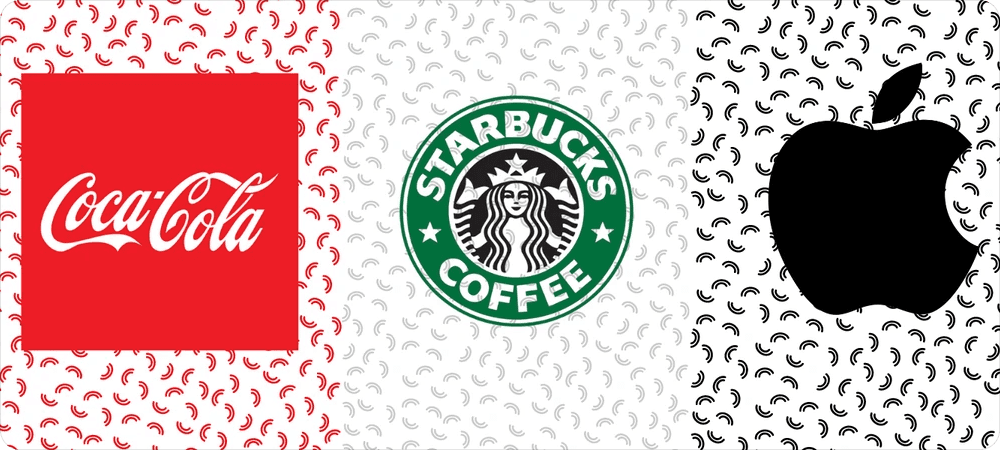The term branding sounds confusing to you? No need to worry, you are not the only one! A term like this can mean many things, which makes it confusing.
Simply, branding is a process in which a company develops a unique image/ identity that’s associated with its products/services. Through this process, customers start to associate your products or services with your brand. And that’s how you build a recognizable brand that distinguishes you from other competitors.
For example, Nike is a lot more than a simple footwear manufacturing company. Their byline is Just Do It, which defines the freedom and motivation they provide to customers through their products. So in a way, Nike has associated themselves with this byline along with the swoosh logo… That’s branding right there!
In other words, to customers isn’t only a company! But it is rather a source of motivation, empowerment, and inspiration for people. And this is strong brand identity.
Similarly, Pepsi has become something bigger than a simple soda. Then there is the Ray-ban, Starbucks, Lamborghini, and so on! All these brands have one thing in common! Which is a unique image /identity that sets them apart from everything else.
By now you must have a basic understanding of what branding is… Now we will take an in-depth look at this concept!
What is branding?
Branding is a process in which a company creates a positive perception of its services/products in the customer’s mind. Effective branding relies on a plethora of tools, such as UX design, logo, mission statement, distinct colors schemes, and a consistent theme. More importantly, branding is all about having a unique story that reflects your brand’s mission & philosophy.
Through branding, a company can make its products or services distinct and unique from its competition. For example, when you see the swoosh logo or byline “Just Do It”, you associate it with Nike.
Similarly, Coca-Cola is a world-renowned brand famous for its unique color scheme, vibrant artwork, and consistent theme. Although they have changed their products' shape, package designs, and logo over the years, it has retained its original branding theme.
However, just sticking to a color scheme or making a unique logo is just a tiny part of branding…
So what is branding all a bout!? Well. it is also the process in which a company incorporates a unique feature in its products and services. That's to say, creating a feature that can only be found in their products or services.
For example, Nike is known for making high-quality footwear products. So in a sense, customers associate quality footwear and high performance whenever they see the Nike logo.
Another brand is Apple; and apart from the bitten apple, the company has branded itself around high security, privacy, and performance when it comes to its products.
So, that's branding in business in a nutshell! No, let's move on to why branding is a critical notion in today's modern world!
Why branding is important
In general, the only bond between a company and a customer is that of the buying-selling relationship. However, when you create an effective brand, you can expand that bond into something far bigger!
One particular which highlights the importance of branding in business is that it helps a business gain a cutting edge over its rivals. On top of that, it also helps acquiring and retaining customers.
For example, whenever someone looks at the cold drink aisle in the supermarket, they will automatically choose Coca-Cola.
Why is that?
Potentially because they associate good taste as well as various other benefits with Coca-Cola. It is possible that other cola brands might have better products… But Coca-Cola has gained the upper hand with superior branding!
So, another benefit of branding for businesses is that it helps you associate positive features with your products/services in the customer’s mind. And once that happens, you start to make new customers and retain the old ones by sticking to your branding!

The importance of branding in business
A brand gives an entire identity to your business and can be compared with a personality.
that's to say, your company have a unique personality, vibration, feeling... and that is your brand!
But why branding in business is so important? Let’s look at some of the factors that highlight the importance of branding in business:
More recognition
One of the biggest reasons why a business needs branding is that it helps in recognition. If your business has strong branding, it will attract more attention and recognition from people than a business without it.
If you are told to tell the name of famous soda brands, you will automatically say Coca-Cola and Pepsi.
Why is that?
It is branding at play!
But if a business doesn’t have cohesive branding, it will fail to last in people’s minds for very long.
De facto, just looking at different parts of your brand identity can help a customer remember your product or service. Even if the customer is not ready to use your products yet, they will remember them due to branding!
Bottomline! Effective branding makes your business easily recognizable to customers!
Better advertising
The cutthroat competition in the modern economy has made advertising an integral part of running a business. Without advertising, your business can’t get very far, and at the core of effective advertising is brand building.
When you are advertising your business, you would want to be cohesive to truly represent your business values and identity.
But if you have yet to form your brand, this can become a challenge. For example, if a customer sees different colors and logos of a company, it would not send a good signal.
In fact, it will mean that you are not effectively advertising your business. This can lead to the customers not recognizing and remembering it!
So, we can also safely say that branding in marketing also plays an important role!
Trust building
As a business, one of the most important things you can do is to gain the trust of your audience. However, it is not so easy to gain this trust in this modern world. And when a business doesn’t have strong branding, it can get even more difficult to gain people’s trust! Without cohesive branding, there’s very little a business can show to potential customers regardless of the industry.
For example, what comes to your mind when you hear the word Toyota? For me, it means affordable yet highly durable cars. As you can see, Toyota build this trust through its branding, which has remained consistent throughout the years!
Similarly, you can see that all major brands compete against each other in trust building. For example, Tesla cars are more famous than other electric car makers. The reason for this popularity can be attributed to the trust building of Tesla!
So in a sense, you can view branding as an investment that allows a business to develop customers’ trust. This trust can actually help a company retain its customers and generate continuous sales!
Good for employees

A company with good branding can make employees feel that they are involved with something bigger than a job.
It also improves their morale and makes them more motivated to work harder. And when we talk about branded merchandise such as shoes and T-shirts, it results in creating unity among the employees.
For any company, its employees are the lifeblood that keeps the company running. Sure, customers are important too but we can’t discount the employees. So one of the internal benefits of branding is that it helps your employees as well!
Brand terms you should know
Want to know about different branding types or branding terms? Let’s have a look at some of the commonly used brand terms and explore their true meaning:
Brand awareness
Brand awareness is used to describe how much recognition a product gets from customers. For example, people can automatically assume that we are talking about fast food when we say the name “Mcdonald’s”. Similarly, famous brands such as Google, NVIDIA, Apple, and others have good brand awareness.
For any business, it is very important to create brand awareness, and it comes with a lot of benefits. But the most important one is in the form of making a product/service stand out from the competition.
Brand extension
The term brand extension is used when a company utilizes its already established brand name on a new product/service. That’s why it is also sometimes called brand stretching as the company stretches its products/service line.
The basic idea is to use the goodwill established by the company’s branding to launch/promote a new product. Using the brand loyalty of the company’s existing customers, the new product/service can be promoted and sold!
For example, if McDonald’s starts offering coffee-holding cups, it could utilize its existing branding to launch and promote it.
Brand identity
If I ask you what your identity is, it would be how you talk, behave, walk, clothes, and so on. Similarly, the brand identity defines the visible elements of a business to help it stand out in the customer’s mind.
Brand identity consists of the logo, design, colors, mission statement, and so on. Basically, it is the collection of all the things which can make a particular business stand out from the competition. In the case of Coca-Cola, it would be its logo, red + white color, unique taste, and good quality. If we talk about Google, that would be its colorful yet simple logo and great search engine.
Brand management
Brand management is a term commonly used in marketing. It refers to the techniques used to increase the value of a service/product over a period of time. Through effective brand management, companies can build loyal customers and even help them in increasing product prices.
Besides increasing the value, brand management is also associated with ensuring that it maintains its current standing in the market.
In big companies, there are usually dedicated teams that oversee brand management through strategic planning.
Brand recognition
This term is pretty self-explanatory and refers to the recognition element of a brand. In simple terms, it refers to how much a consumer can identify the features of one company against its competition.
A company with successful brand recognition can attract customers through a combination of auditory and visual clues alone.
For example, you can instantly recognize Starbucks coffee by just looking at the logo. In such a situation, there will be no need to hear the company’s name!
Brand trust
Brand trust refers to the trust/confidence of customers in a particular brand. That trust can be in the form of quality, quantity, or even other means. For example, people trust Nike’s ability to deliver high-performance and high-quality shoes.
To maintain brand trust, a company needs to ensure that it continues to meet consumer expectations. On the other hand, brand trust deteriorates when the company fails to uphold its values and perceived quality.
Brand valuation
Brand valuation is a method that is used to calculate the exact monetary value of a brand. For example, the brand valuation of Apple was $355.1 billion in 2022. This made it one of the most valuable brands!
To determine the brand valuation, both the tangible and intangible elements are accounted for. This can include the company’s culture, style, messages, value proposition, and so on.
Branding tips for small businesses
I think by now, you would already know that branding is indeed important for any business (small or large). This leads us to another question… Is branding only reserved for the big companies with a lot of money to spend? Well, you do not need a million dollars for effective branding for your small business!
All you need is a little bit of common sense and brainstorming to turn your small business into a brand. So without wasting time, let’s take a quick look at some easy and workable branding tips for small businesses.
Know your target audience
There is always a risk when it comes to launching a new company, service, or product. To minimize this risk and for effective brand marketing, you need to know about the market situation first.
When it comes to marketing success, you need to know exactly who your target audience is… Once you know this, the next thing to know is how you will reach them. Generally, starting with focusing on a specific market segment is far more beneficial than being too broad.
In simple words, be precise about what type of people will buy your product or service. Using this information, you can ensure that your branding activities align with your target audience.
You also need to understand that different demographics require different messages. In fact, the same message can have different effects on different target audiences.
Clearly define yourself
Good branding isn’t just the use of eye-catching images and snappy titles. In fact, it is all about creating a connection between the services/products you offer and your business identity.
Basically, all businesses are run to gain money, and there’s nothing wrong with that. But it is not enough of a reason for your customers to support or stand behind your business!
So the second thing you need to do is clearly define the goals and values of your business. Why are you selling a particular product? Who are you (as a brand)? What difference are you making in someone else’s life? Ask all of these questions to clearly define your business.
Create a mission statement
If you look at any major company or brand, you will realize that they all have a mission statement. As a small business, you must create a mission statement that aligns with your target audience and brand values.
A good mission statement includes information about the company’s objectives as well as how it will benefit consumers. You can start by explaining what your brand does along with its impact on the world!
As your small business grows, you can always redefine the goals and the mission statement to reflect the change.
Get Feedback
Earlier, we talked about the benefit of getting to know your target audience… So, you can use that information to get feedback from your target audience!
It is only through asking questions that you can get to know what’s going on in the customer’s mind. Using this information, you can redefine your branding to better align your company in the consumer’s eyes.
Some of the questions you can ask include:
- How satisfied are customers with your product/service?
- What can you do to improve your product/service?
- Are your employees satisfied?
Be consistent
Small businesses make a very common mistake when it comes to branding… They lack consistency! Even small changes, such as a new font, colors, or theme, can dent your brand’s awareness, recognition, and trust.
Another mistake people make is to have different styles on different media. These days, companies ensure that their messaging and brand identity remains consistent throughout different channels. This includes your website, email, and social platforms (IG, Facebook, & Twitter).
One of the easiest ways to remain consistent in your branding is to develop clear brand guidelines in written form.
These are the things you need to keep in mind for consistency in your branding efforts:
- Fonts – Clearly define your primary and secondary font, and then stick to it.
- Logo – Your logo must be similar in different media (print and digital).
- Colors – Choose a list of your primary and complementary colors and then stay consistent with them.
- Images – Define what types of images are acceptable for your brand and what is not.
- Tone – Once again, the tone should depend on your target audience (who your ideal customer is). Once you have established a tone and a voice of your brand, stick with it on all channels.
Unique Selling Proposition (USP)
What makes your small business different and unique from others? For successful branding, you need to clearly define your unique selling proposition (USP).
In order to create a USP, you need to start with proper research of your competition… Once you know about the weaknesses/strengths of your competitors, you can figure out what makes you unique from others. But if there is no USP in your products/services, then you will need to make one!
When making a USP, you also need to keep your target audience in mind. A good USP is one that improves the life of the consumers or fills a gap in the market. Creating a USP that doesn’t relate to consumers or fulfills a market demand will not get you anything!
Use your logos everywhere
Logos are not just pretty emblems that you can use every now and then. Instead, it represents your entire brand visually and is often the first thing potential consumers see!
To take full advantage of logos, the first step is to actually create a logo that clearly defines your brand. When making a logo, many things come into play, such as the target market, brand tone, etc.
Once you have a good logo, use it everywhere, such as web, email, Facebook, Twitter, print media, etc. This consistency in using logos everywhere will improve brand awareness and will help you in recognition as well. If a consumer sees a similar logo on 4-5 different media, they will start to remember the brand name.
On the other hand, if consumers see different logos on multiple media, they will have difficulty recognizing the brand.
Branding VS Marketing: what’s the difference?
In simple words, branding is the visual and auditory identity of your business. On the other hand, marketing refers to the techniques you use for selling products.
Although both of these terms are different, they have a deep connection with each other & often go hand in hand. For effective marketing, consistent and clear branding is very important for proper results and even sales generation!
Branding can include the following:
- Mission statement
- Core values
- Unique selling point (USP)
- Brand personality
- Colors, themes, logo, and font.
Marketing is just the use of brand identity for the promotion, recognition, and selling of products or services. A lot of different channels can be used for marketing, such as:
- Word of mouth
- Social media marketing
- Print marketing
- Network Marketing
- Influencer marketing
And so on…
Final thoughts
Just like we humans tend to have our own personalities, different companies also have their own personalities. These personalities are called brands, and branding is the art of building that personality.
A lot of different components go into the branding efforts, many of which are already discussed above. Just for the recap, it includes a logo, tagline, manifesto, brand voice, colors, fonts, and a consistent theme. Besides that, your unique selling point (USP) and how you can impact the consumer’s life also play an important role.
Written by

I am the CEO and founder of Overmentality. I am a professional business and technical blogs writer and on-page SEO specialist. I hold a degree in Culture Studies and Media Literacy from the English Humanities and Art Department. And I am interested in Digital Marketing, Business, Entrepreneurship, Leadership, and pets of course!
You can reach me via email here: hamiidnouasria@gmail.com
Or find me on my LinkedIn Profile.







